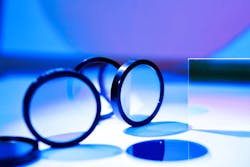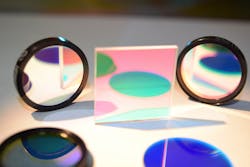Building precision, accuracy, and speed into the analytical instruments used in health and life science
Sustaining and improving life are the goals of the analytical instruments used in the health and life sciences. Flow cytometers, microplate readers, spectrometers, hematology analyzers, and other tools enable the study of living organisms at the molecular and cellular levels, which helps scientists gain a deeper understanding of the underlying mechanisms of diseases and biological processes (see Fig. 1).
Over time, these instruments have become more sophisticated, precise, and efficient, allowing researchers to perform experiments and analyses with greater precision, accuracy, and speed. However, continued advancements do not rely solely on the evolution of technology. There is another way to fundamentally improve the overall system performance for these instruments—through the strategic integration of custom components designed with performance characteristics that include measurement resolution, accuracy, precision, and repeatability.
These important and enabling optical components, like diffraction gratings, optical filters, and reflective mirrors, can be custom-designed and manufactured to improve the performance of measurement systems at the building block level. Critical factors that system designers must consider are desired instrument resolution, instrument footprint, energy budget, instrument environment, reliability, and cost.
Flow cytometry
The analytical process of flow cytometry allows the swift examination of individual cells or particles, shedding light on vital characteristics as they traverse a laser-generated beam. A flow cytometer takes a sample of cells, transitions them into a single stream, and uses light sources to excite biomarkers or labels on the cells to count the number of relevant constituents. The properties measured include relative particle size, relative granularity or internal complexity, and relative fluorescence intensity. Using custom-designed optical components to enhance the overall system performance of these instruments increases the precision and speed of analyses and, therefore, time to market for life-changing discoveries and treatments.
This technique’s rise has been propelled by its ability to address critical concerns within medical and scientific domains—from battling targeted diseases such as cancer and HIV/AIDS to tackling contemporary challenges, including COVID-19 and stem cell research. Yet, there are some obstacles.
Flow cytometry involves working with extremely weak optical signals that can be easily overwhelmed by background noise. The optimization of instrument components that excel within this area is critical for successful measurements: high signal-to-noise-ratio (SNR) and high temporal resolution in flow cytometry signals.
In multiwavelength flow cytometers, the data sets must be clearly delineated to minimize overlap and increase confidence in the measurement data or risk misclassification and costly, unplanned outcomes. Achieving these signal characteristics places large demands on the quality of a flow cytometer’s components. Laser light sources, optomechanical components, and optics must have exceptional accuracy and stability, while narrowband optical filters must have high transmission and exceptional out-of-band blocking to minimize background interference.
The significance of optical filters is especially crucial for the detectors in the machine, as high-functioning optical filters allow precise signal detection and the flow cytometer to operate at its full potential. Unwanted signals must be blocked as much as possible—at a minimum, OD6- to OD8-quality optical filters should be utilized to serve against unwanted interference.
The functionality of flow cytometers relies on high precision throughout the instrument. High optical density is crucial from the emission filter into the excitation band and from the excitation filter into the emission band. This requirement drives the need for a steep transition slope from the transmission-to-rejection region and vice versa. If the transition is not steep enough, unwanted optical signals might reach the detectors even with a high optical density. Since as many as possible of the intended signals must pass through the filter, filters with at least 90% passband transmission and in-band transmission levels of ≥95% are ideal.
MKS Newport, for example, collaborates closely with instrument developers to sculpt optical filters tailored to the intricate demands of flow cytometers. These filters, fine-tuned to amplify desired signals while quelling unwanted interference, allow researchers to explore myriad biological applications in their inexorable quest to boost system performance and deliver precision and reliability (see Fig. 2).
Microplate readers
Microplate readers, which use optics for measurement, decipher chemical, biological, and physical reactions within microplate wells (see Fig. 3). Compared to a standard spectrophotometer that measures one probe at a time in a cuvette, a microplate reader measures the same absorbance assay with much higher throughput. The instrument works by shining a light source through a filter or a monochromator, and then the filtered beam is directed to the plate. Light passes vertically through the plate wells, hitting a detector that transmits information about the wavelengths in the sample to a computer. Because the source wavelength is slightly different than the emitted light, it allows the emitted light to be measured separately from the source.
A microplate reader primarily measures ultraviolet or visible absorbance, luminescence, and fluorescence. Applications vary depending on the microplate measurement in question. In general, however, microplate readers are excellent tools for protein-related assays, including ELISA, DNA, RNA quantification, Bradford assay, cell viability, cytotoxicity, BRET, enzymatic reaction assay, FRET, flux and signaling, and gene expression assay.
Custom-designed diffraction gratings and optical filters can optimize a microplate’s performance, ensuring an ideal level of performance for the overall instrument. Microplate readers depend on a wide range of wavelengths to both excite the individual cells and measure the output.
Diffraction gratings, used in a monochromator, provide a constant low-energy wavelength selective excitation source. These gratings must be designed with high spectral resolution, high efficiency at the desired wavelengths, and aberration correction to operate within the microplate. The groove frequency, groove profile, and reflective coatings are critical design variables that determine overall microplate system performance.
Optical filters must diminish SNR, ensuring the purity of measurements. With high transmission rates, excellent blocking performance (OD8 at desired wavelengths), and steep transmission slopes, these filters deliver precision. The fusion of technological evolution and strategic customization echoes through these components, asserting their influence on the overall functionality/optimization of the microplate reader (see Fig. 4).
Optical components are the building blocks of many instruments used in health and life sciences to create a better life for all of humanity. Proper design and application of individual components in an optical measurement system ensure the highest level of instrument performance. Optimized optical component design resides at the intersection of optical component design and application knowledge. Working with an experienced and knowledgeable optical component partner often yields outsized results, bringing about a superior measurement instrument.
While these unheralded custom optical components remain hidden within the instrument, they often play a vital role in instrument performance—improving and safeguarding human and animal life.
“For who has health has hope; and who has hope, has everything.” – Thomas Carlyle. Optical components are the core of these innovations, building the precision, accuracy, and speed that enable instruments to create life and sustain hope.
About the Author
Robert Bourdelais
Senior Global Business Development Manager, MKS Newport
Robert Bourdelais is senior global business development manager at MKS Newport (Rochester, NY). He holds an MS in Mechanical Engineering from the Rochester Institute of Technology, a BS in Mechanical Engineering from the University of Buffalo, and a BS in Physics from Geneseo College.
Robert has 30 years of combined experience in engineering, R&D, operations management, product management, marketing, and sales. He has published several research papers, presented at various industry conferences, and has authored over 190 US patents. In 2002, Rob was awarded the prestigious Eastman Innovator award and was a multi-year member of the Eastman Kodak Research Scientific Council.



